
The Hertefeld Castle estate, consisting of a castle ruin and attached park, stands in the town of Weeze in North Rhine-Westphalia. It was established in the fourteenth century.

The Hertefeld Castle estate, consisting of a castle ruin and attached park, stands in the town of Weeze in North Rhine-Westphalia. It was established in the fourteenth century.
The castle was first mentioned as a knight's seat in 1322. However, it appears that a family of this name lived nearby for significantly longer, since a man named Theodoricus de Hertevenlde was first mentioned in 1179.
In the fourteenth century the castle was the center of an independent domain. However, this independence disappeared in the following years de to increasing subservience to the dukedom of Cleves. In 1322, the domain excluding the castle was sold in 1322 by Wilhelm von Herteveld to Graf Dietrich VII of Cleves. Three years later, the castle too entered the ownership of Cleves. However, the castle was later returned to the Herteveld family in the person of Stephan II von Herteveld, but now as a loan from the house of Cleves.

Following the death of the count Stephan IV in 1485, the family was divided via his two sons into two branches. With the senior branch acquiring through marriage the castle of Kolk in Uedam, Hertefeld castle passed to the junior branch under count Heinrich. This branch later died out in the direct line with Elbert von und zu Hertefeld, who however transferred the estate to his stepbrother Elbert von Steenhaus. Facing financial difficulties, Elbert in turn passed it to his relative Jobst Gerhard von Hertefeld, thereby reunifying the property of the two branches. The hartefeld properties had by this time become quite extensive, incorporating not just Uedam and Weeze but also Boetzelaer castle, Hoennepel, Kervenheim and Zelhem (today part of Bronckhorst).
Jobst Gerhard's father had previously through his good relations with the Duke of Brandenburg, Friedrich Wilhelm, inherited the property of Liebenberg in Brandenburg, which he later made the principle residence of his family. His grandson, Samuel von und zu Hertefeld, was raised to the rank of Freiherr by Friedrich I of Prussia, who frequently lodged at Hertefeld castle during his tours of inspection along the lower Rhine. Another prominent guest was Tsar Alexander I of Russia.
The male line of the family died out in 1867 with Karl von Hertefeld, whose grandniece Alexandrine inherited the property. Since she was married to Philipp Konrad zu Eulenburg, Hertefeld became incorporated into his family property. Alexandrine's son Philipp zu Eulenburg became a personal friend of Wilhelm II, who raised him in 1900 to the rank of Furst. Since the family had also acquired the title of Graf from the king of Sweden, he and his successors were henceforth able to style themselves "Fürst zu Eulenburg und Hertefeld, Graf von Sandels". Philipp himself became notorious only a few years later as a result of the Harden-Eulenburg Affair, in which he became a target of the influential publicist Maximilian Harden. In several court cases, he defended himself against allegations of homosexuality without being convicted.
Alexandrines second, Botho Sigwart, became the first family member for some time to make Hertefeld his long-term residence. His opera "Songs of Euripides", which premiered in 1915 at the royal Staatstheater Stuttgart. The principal line of the family returned to Hertefeld at the end of the Second World War, after their principal residence at Liebenburg was confiscated by the East German government.
The estate complex today (which is legally preserved as a historic monument), consists of the partially renovated castle ruins, the well-preserved Renteigebäude, and the keepers' lodges, together with a park of roughly 5 hectares. Within the park are an earlier agricultural yard and a small animal park.
Archeological evidence indicates that the site has been in use since the thirteenth century. The predecessor of today's castle, in all probability am inhabited tower or fortified house, dates from the fourteenth century. Around 1500 a gabled building was constructed including a room on the upper floor extending nearly six meters high. Around 1600 the building was extended with a gate tower.
The current building acquired its basic form through the reconstruction and extensions of Samuel von und zu Herteveld. In around 1700, he ordered the main house converted to a Baroque castle, and six years later constructed the "Renteigebäude". The main building acquired two wings with hipped roofs, and the three-storey gate tower was given a Baroque hemet and flanking staircase towers. Function rooms were installed, while the high living rooms were equipped with three meter tall windows. On the north side of the precinct, a Baroque garden was laid out in French style. The main building was surrounded by a moat and accessible only over a wooden bridge via a gatehouse on an island.
Later changes were of only minor or restorative character. In the first third of the eighteenth century the large uneconomical windows in the upper floor were reduced in size. From 1904 the castle was renovated by Furst Philipp. The building acquired steam heating, the gate tower a stoop, and on the north side of the park two watchtowers were constructed.
In February 1945, during World War II, the castle was burnt down. The Rentegebäude was also badly damaged, but was made inhabitable by Fürst Friedrich-Wend in 1946. The park was laid out anew in English landscape style on the foundations of the old moats (some of which had already been filled in the early 19th century.) Partes of the old French gardens were incorporated into this design.

Between 1998 and 2006, the castle ruins were restored. An idea formulated in 1947 was carried out: what remained of the castle was examined and measured and partially rebuilt. The central portion of the building and the historic main tower were recreated, and in April 2005 the tower was given a replica of its original Baroque cap, based on a 1734 drawing by Jan de Beijer, which was fashioned from some ten tonnes of oak, and a 280 kg bronze bell, inscribed with the Hertefeld arms, the year 2004, and the motto Gottes Wort bleibt ewig (The word of God remains eternally).
The formerly overgrown park was also restored.
The castle remains in the possession of the family and is now a successful hotel. The ruin, the rental building, the guardhouses and the park are available for overnight visits, events, weddings and conferences.

Chlodwig Carl Viktor, Prince of Hohenlohe-Schillingsfürst, Prince of Ratibor and Corvey, usually referred to as the Prince of Hohenlohe, was a German statesman, who served as the chancellor of the German Empire and minister-president of Prussia from 1894 to 1900. Prior to his appointment as Chancellor, he had served in a number of other positions, including as minister-president of Bavaria (1866–1870), German Ambassador to Paris (1873–1880), Foreign Secretary (1880) and Imperial Lieutenant of Alsace-Lorraine (1885–1894). He was regarded as one of the most prominent liberal politicians of his time in Germany.

The House of Schönborn is the name of an ancient noble and mediatised formerly sovereign family of the former Holy Roman Empire.

The House of Hohenlohe is a German princely dynasty. It formerly ruled an immediate territory within the Holy Roman Empire, which was divided between several branches. In 1806, the area of Hohenlohe was 1,760 km² and its estimated population was 108,000. The motto of the house is Ex flammis orior. The Lords of Hohenlohe were elevated to the rank of Imperial Counts in 1450, and from 1744, the territory and its rulers were princely. In 1825, the German Confederation recognized the right of all members of the house to be styled as Serene Highness, with the title of Fürst for the heads of its branches, and the title of prince/princess for the other members. From 1861, the Hohenlohe-Öhringen branch was also of ducal status as dukes of Ujest.

Philipp, Prince of Eulenburg and Hertefeld, Count of Sandels was a diplomat of the German Empire who achieved considerable influence as close friend of Wilhelm II, German Emperor.

Weeze is a municipality in the Lower Rhine (Niederrhein) region, located in the northwestern part of North Rhine-Westphalia, specifically in the district of Kleve and the Düsseldorf region.

The House of Schwarzenberg is a German (Franconian) and Czech (Bohemian) aristocratic family, formerly one of the most prominent European noble houses. The Schwarzenbergs are members of the German and Czech nobility, and they once held the rank of Princes of the Holy Roman Empire. The family belongs to the high nobility and traces its roots to the Lords of Seinsheim during the Middle Ages.
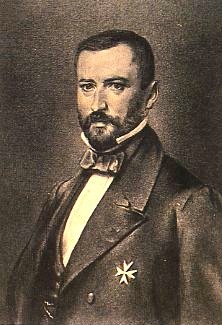
Count Friedrich Albrecht zu Eulenburg was a Prussian diplomat and politician. He led the Eulenburg Expedition and secured the Prusso-Japanese Treaty of 24 January 1861, which was similar to other unequal treaties that European powers held Eastern Countries to.
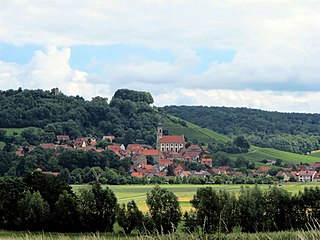
Castell is a municipality in the district of Kitzingen in Bavaria in Germany. It was the seat of the Counts of Castell. Today it is part of the municipal association Wiesentheid. It has around 800 inhabitants.
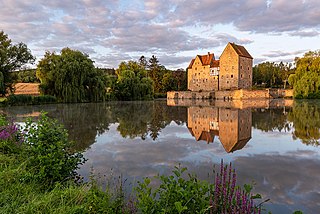
Brennhausen is a castle in the municipality of Sulzdorf a.d.Lederhecke in the district of Rhön-Grabfeld in Bavaria in Germany. It is located the Haßberge Nature Park.
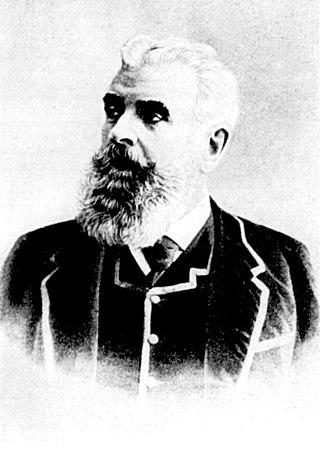
Guido, Prince Henckel von Donnersmarck, previously Count Guido Henckel von Donnersmarck, was a German nobleman, industrial magnate, member of the House of Henckel von Donnersmarck and one of the richest men of his time. He was married in his first marriage to the famed French courtesan Esther Lachmann, known as La Païva, of Russian Jewish origin.

The Friedrich Order was an order of merit of the German Kingdom of Württemberg. It was instituted on 1 January 1830 by the second king of Württemberg, Wilhelm I in remembrance of his father, King Friedrich I. In 1918, the end of the monarchy meant the abolition of the order.

The House of Khevenhüller is the name of an old and important Carinthian noble family, documented there since 1356, with its ancestral seat at Landskron Castle. In the 16th century, the family split into the two branches of Khevenhüller-Frankenburg, Imperial Counts from 1593, and Khevenhüller-Hochosterwitz, raised to Imperial Counts in 1725 and, as Khevenhüller-Metsch, to princely rank (Fürsten) in 1763. The family belongs to high nobility.

The House of Dietrichstein was the name of one of the oldest and most prominent Austrian noble families originating from Carinthia. The family belonged to the High Nobility, the Hochadel. The Nikolsburg (Mikulov) branch was elevated to the rank of Prince of the Holy Roman Empire in 1624, while a member of the Hollenburg branch was elevated to the same dignity in 1684. The family hold two groups of territories: the Principality of Dietrichstein, some castles in Carinthia and Moravia, and the Barony of Tarasp in Switzerland.
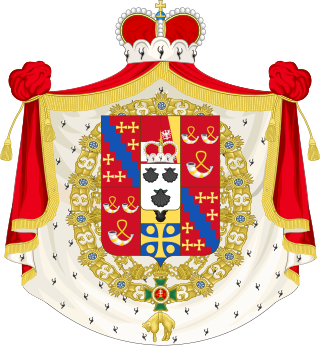
The House of Metternich was an old German noble family originating in the Rhineland. The most prominent member was Prince Klemens von Metternich, who was the dominant figure at the Congress of Vienna (1814–1815). As a former reigning house (mediatised), the Metternich family belonged to the small circle of high nobility.

Count Christian Frederick of Stolberg-Wernigerode was the only son of Count Henry Ernest of Stolberg-Wernigerode, whom he succeeded as ruler of the County of Wernigerode in 1778.

Doña Esperanza Felicitas Alexandra de Sarachaga y Lobanov Rostovsky was a 19th-century courtier and socialite of Spanish and Russian descent. Born in St. Petersburg, she was informally known as “Spera”. She was the eldest daughter of Don Jorge de Sarachaga y Uría and his Russian wife Princess Ekaterina Lobanov-Rostovskaya. Her father, also known as Georg von Sarachaga-Uria was born in Manzanares, Spain and killed near Mannheim in a duel. Esperanza married Bavarian diplomat, Friedrich Freiherr Truchseß von Wetzhausen.

The Grynau Castle is the name of a castle tower in the municipality of Tuggen in the canton of Schwyz, built by the House of Rapperswil in the early 13th century AD.
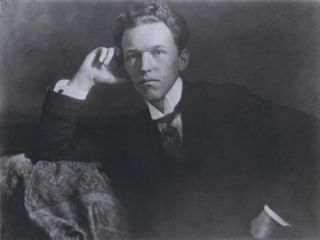
Sigwart Botho Philipp August zu Eulenburg, Count of Eulenburg was the second son of Philipp, Prince of Eulenburg (1847–1921) and his wife Augusta, born Countess of Sandels (1853–1941) and a German late romantic composer who fell in the First World War.

Friedrich-Wend, Count of Eulenburg and Hertefeld, known as Prince of Eulenburg and Hertefeld, Count of Sandels, was a German aristocratic farmer and estate owner of Liebenberg and Häsen in (Brandenburg) as well as Hertefeld and the Castle of Kolk (Niederrhein).
Augusta, Princess of Eulenburg and Hertefeld was a princess and spouse of Philipp, Prince of Eulenburg, who achieved considerable influence as the closest friend of Wilhelm II. The princely family of Eulenburg struggled from the so-called Eulenburg affair when Philipp was accused of homosexuality.